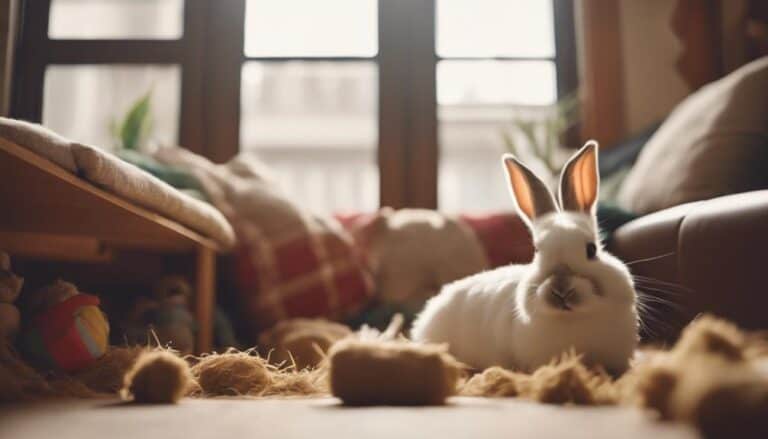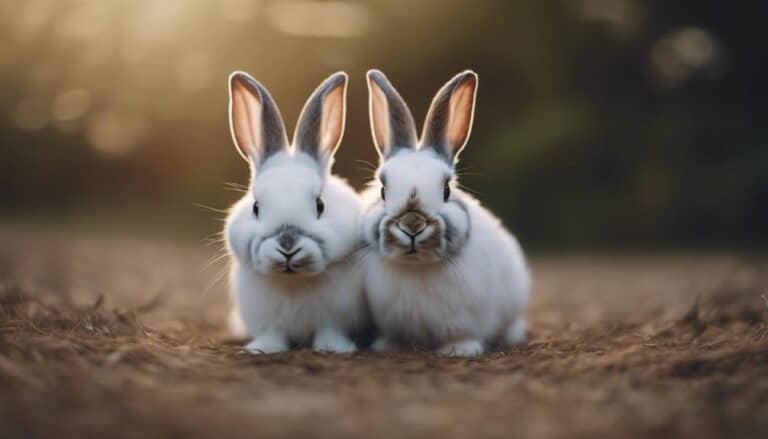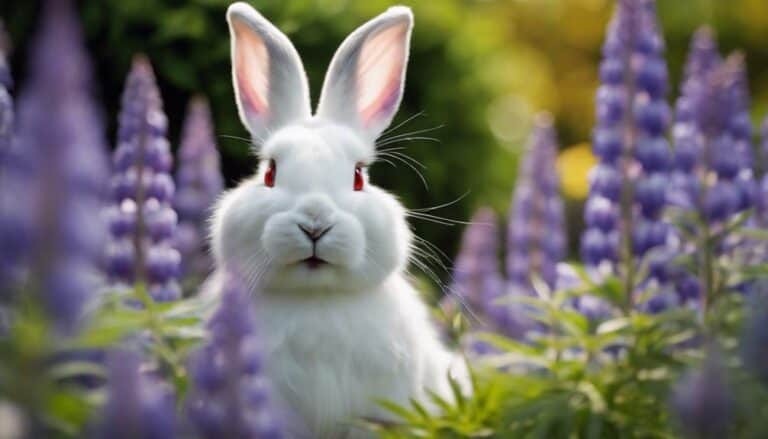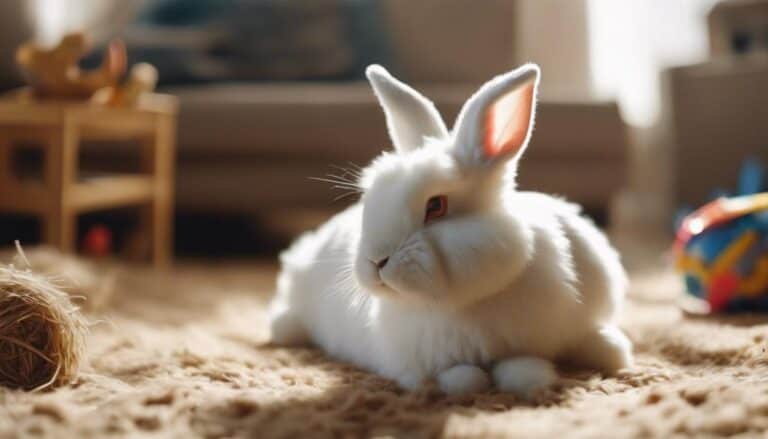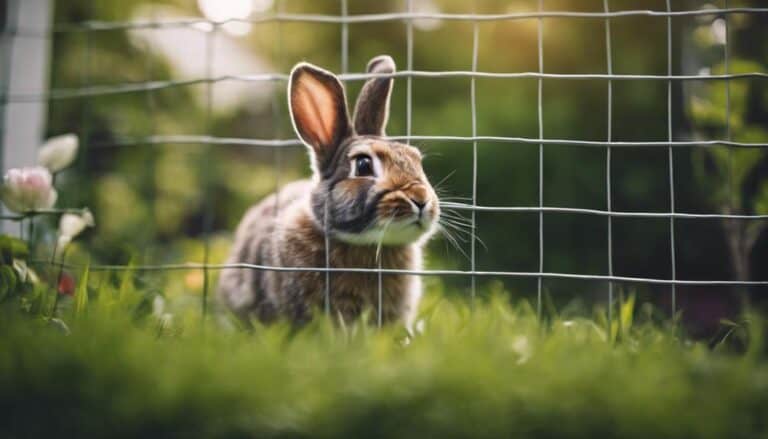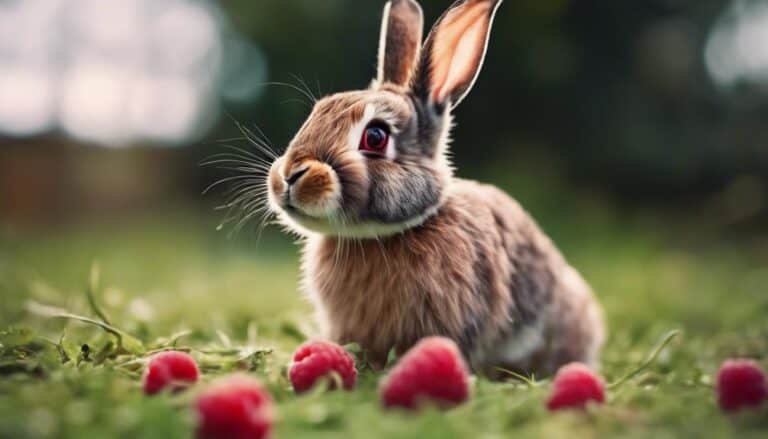So, you're thinking about bringing those adorable bunnies indoors, huh? Before you start rearranging your living space, there are a few important factors to contemplate.
Ensuring the well-being of indoor bunnies goes beyond just providing a cozy spot; it involves creating a safe environment that meets their unique needs. From bunny-proofing your home to understanding their housing essentials, there's a lot to explore when it comes to keeping bunnies inside.
Stay tuned to discover the key elements that make indoor bunny living not just possible but also enriching.
Contents
- 1 Key Takeaways
- 2 Benefits of Indoor Rabbit Living
- 3 Creating a Safe Indoor Environment
- 4 Enrichment Activities for Indoor Bunnies
- 5 Bunny-Proofing Your Home
- 6 Indoor Rabbit Housing Essentials
- 7 Health and Safety Considerations
- 8 Will Keeping Bunnies Inside Lead to Overeating?
- 9 Frequently Asked Questions
- 10 Conclusion
Key Takeaways
- Indoor living provides safety, well-being, and longevity for rabbits.
- Bunny-proof your home for a secure and interactive indoor environment.
- Enrichment activities promote mental and physical health for indoor bunnies.
- Ensure essential housing elements like bedding, hay, and space are met for indoor rabbits.
Benefits of Indoor Rabbit Living
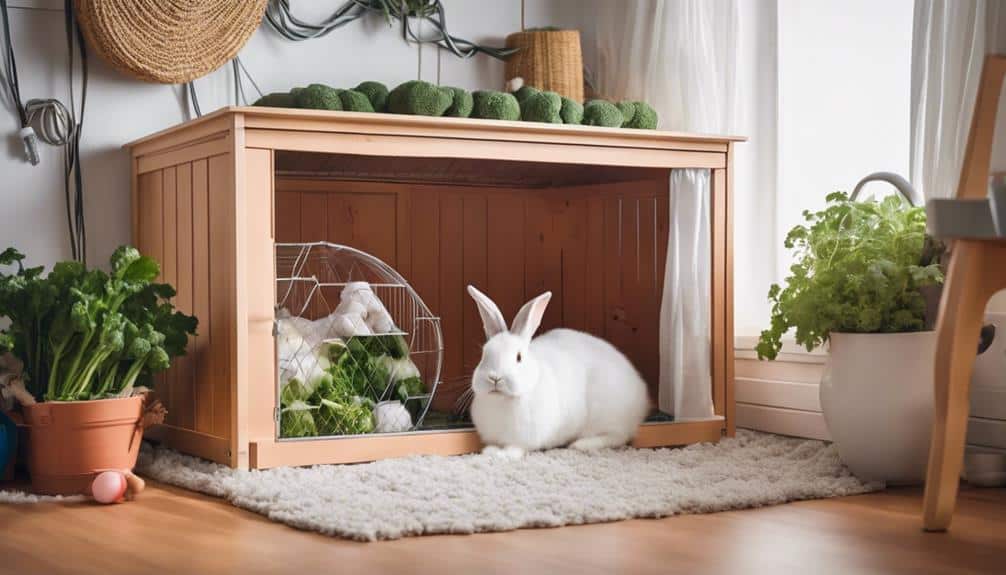
When considering the benefits of indoor rabbit living, you provide a safe and controlled environment that shields your rabbits from outdoor threats and promotes their overall well-being. As prey animals, indoor rabbits are protected from predators and adverse weather conditions, ensuring a secure living space. Additionally, keeping rabbits indoors facilitates increased human interaction, leading to early illness detection. By closely monitoring your pet rabbits in an indoor setting, you can swiftly identify signs of pain or injury, enabling prompt intervention and care. This proactive approach to healthcare greatly contributes to their health and well-being.
In addition, indoor living reduces exposure to diseases and parasites that outdoor rabbits might encounter, ultimately resulting in a longer lifespan for your furry companions. The controlled environment indoors not only safeguards them from external dangers but also fosters a sense of security and comfort.
Creating a Safe Indoor Environment
To maintain the safety and well-being of your indoor rabbits, establishing a secure environment is paramount. Indoor living provides protection from outdoor threats like predators and adverse weather conditions. It also increases human interaction, aiding in early illness detection and injury recognition.
To create a safe habitat for your pet rabbits, consider bunny-proofing your house to prevent accidents. Provide a designated living area equipped with a litter tray, fresh water, and rabbit-friendly toys to keep them entertained and engaged.
Ensuring a safe indoor environment not only reduces the risk of diseases and parasites but also contributes to a longer lifespan for your beloved bunnies. Regularly inspect the living space for any potential hazards and make adjustments as needed to maintain a secure and comfortable environment for your indoor pets.
Enrichment Activities for Indoor Bunnies
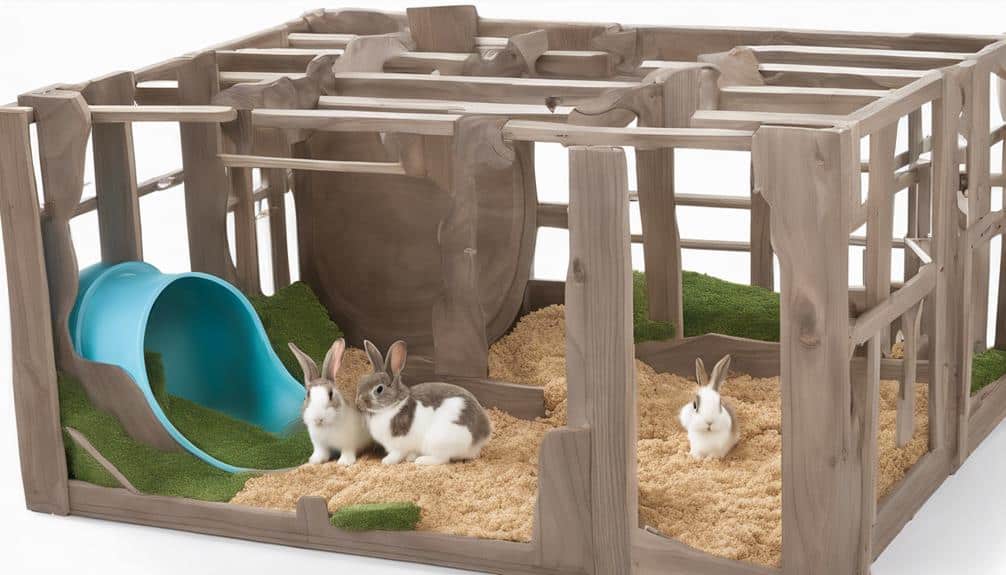
Enhancing the indoor environment for your bunnies involves incorporating various enrichment activities to promote their mental and physical well-being. Guarantee your bunnies have enough space to move around freely and explore.
Providing access to fresh, interactive feeding toys can encourage natural foraging behaviors, keeping them mentally stimulated. Including tunnels and hiding spots in their living area offers opportunities for exploration and play, preventing boredom.
Rotate their toys regularly and change up their environment to prevent habituation and keep them entertained. Consider supervised playtime outside of their enclosure to provide additional enrichment and stimulation.
Bunny-Proofing Your Home
Consider securing potential hazards and creating a safe environment by bunny-proofing your home to safeguard your indoor rabbit's well-being. To keep your rabbit safe indoors, guarantee wires, cords, and toxic items are out of reach to prevent chewing and ingestion hazards.
Utilize a playpen to limit access to hazardous objects while offering a secure play area. When allowing free roaming, closely monitor your rabbit to prevent accidents and ascertain their safety. Protect wooden furniture legs and baseboards from chewing by using protective covers or deterrents.
Implement precautions to maintain a rabbit-friendly environment and avoid potential dangers. By taking these steps, you can create a safe and enjoyable indoor environment for your rabbit, promoting their well-being and happiness. Remember that a well-bunny-proofed home not only enhances your rabbit's safety but also contributes to their overall health and quality of life.
Indoor Rabbit Housing Essentials
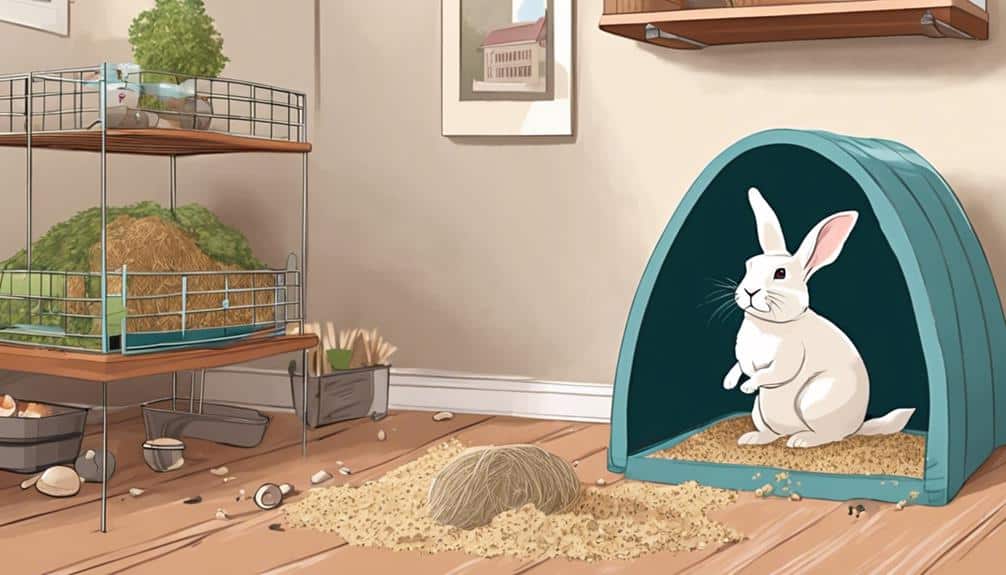
Guarantee that your indoor rabbit housing offers a minimum living area of 10 ft x 6 ft x 3 ft for a pair of rabbits. To make certain a comfortable and safe environment for your indoor bunnies, here are essential tips to follow:
- Provide Proper Bedding and Litter Box Space: Utilize rabbit-friendly bedding and allocate a specific area for a litter box to maintain cleanliness and offer a cozy space for your rabbits.
- Offer Access to Hay: Make sure your rabbits have constant access to hay, such as Timothy or alfalfa, as it's crucial for their digestive health and dental care, even when indoors.
- Use Suitable Litter Materials: Opt for rabbit-friendly litter materials like newspaper and hay in a litter tray to keep your indoor space tidy and promote good hygiene for your rabbits.
Health and Safety Considerations
When considering the health and safety of your indoor bunnies, creating a safe environment is paramount.
Regularly checking your bunny's health by observing their behavior and monitoring their eating habits can help detect any issues early on.
Ensuring a secure living space won't only protect your bunnies from harm but also contribute to their overall well-being and longevity.
Indoor Bunny Environment
Creating a secure and hazard-free indoor environment is essential for safeguarding the health and safety of your indoor bunnies. Here are three key points to contemplate:
- Provide Plenty of Room: Confirm your pet rabbits have enough space to move around freely. Contemplate a secure run or play area to promote exercise and mental stimulation.
- Use High-Quality Feeding Hay: Pet rabbits need good quality hay to maintain digestive health. Make sure they've a constant supply of fresh hay available at all times.
- Keep Them Well Ventilated: Indoor spaces need to be well ventilated to provide fresh air for your bunnies. Proper ventilation helps maintain a healthy environment and reduces the risk of respiratory issues.
Bunny Health Checks
Regularly conducting thorough health checks on your bunny is important for ensuring their well-being while living indoors. Provide your rabbit with free access to quality hay, water, and safe spaces to roam around happily indoors.
Keeping your rabbit indoors allows you to closely monitor their health. Set up litter trays for your bunny to maintain cleanliness and observe their bathroom habits. Check your bunny's eyes, ears, nose, teeth, fur, and behavior regularly for any signs of illness.
Monitor their eating and drinking habits to guarantee consistency. If you notice any abnormal symptoms or behaviors, consult with a veterinarian promptly. Keeping a record of health checks and veterinary visits will help you track your rabbit's health history for the best care.
Will Keeping Bunnies Inside Lead to Overeating?
Keeping bunnies indoors may increase overeating risks due to limited space for exercise. Without access to grass and hay, they may overconsume pellets, leading to obesity and health issues. It’s crucial to monitor their diet and provide opportunities for physical activity to prevent bunnies and overeating risks.
Frequently Asked Questions
Is It OK to Keep Rabbits Indoors?
Keeping rabbits indoors is beneficial for their well-being. Indoor rabbit behavior, care, diet, exercise, enrichment, health, grooming, socialization, space, and litter box management are important. Providing a safe indoor environment guarantees a happy and healthy rabbit.
Do Bunnies Make Good Indoor Pets?
Bunnies make excellent indoor pets. They enjoy potty training, need exercise and playtime activities, require bunny proofing, benefit from bonding time, require grooming, offer health benefits, develop socialization skills, need a proper cage setup, and thrive in an adequate enclosure size.
Are Bunnies Happier Inside or Outside?
Indoor bunnies are typically happier due to increased safety, human interaction, and health benefits. They thrive in a secure, enriching environment, leading to longer lives. Keep your bunnies inside for a healthier, happier life.
Do Indoor Bunnies Smell?
Indoor bunnies generally don't smell if you keep their area clean. Daily hygiene like removing soiled bedding and providing fresh food/water helps. Bunnies groom themselves, reducing odor. Healthy diet, fresh air, and playtime also help.
Conclusion
Now that you have learned about the benefits of keeping bunnies inside, creating a safe indoor environment, enrichment activities, bunny-proofing your home, housing essentials, and health considerations, you're ready to provide your indoor bunnies with the best care possible.
Remember, a happy and healthy bunny is a joy to have indoors, so make sure to continue implementing these tips to guarantee their well-being and happiness.

